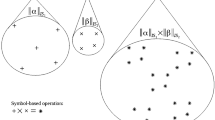Abstract
In “real world” databases, attribute domains are more than Cantor sets; the additional semantics defined, in this paper, is assumed to be carried by a binary relation. Association rules in such databases are investigated. In this paper, we show that the cost of checking the additional semantics is rather small. Some experiments are reported.
Preview
Unable to display preview. Download preview PDF.
Similar content being viewed by others
References
T. Y. Lin, “Data Mining and Machine Oriented Modeling: A Granular Computing Approach,” Journal of Applied Intelligence, Kluwer, Vol. 13, No 2, September/October, 2000, pp.113–124.
T. Y. Lin, “Data Mining: Granular Computing Approach.” In: Methodologies for Knowledge Discovery and Data Mining, Lecture Notes in Artificial Intelligence 1574, Third Pacific-Asia Conference, Beijing, April 26–28, 1999, 24–33.
T. Y. Lin, “Granular Computing on Binary Relations I: Data Mining and Neighborhood Systems.” In: Rough Sets In Knowledge Discovery, A. Skoworn and L. Polkowski (eds), Springer-Verlag, 1998, 107–121.
T. Y. Lin, “Neighborhood Systems and Relational Database”. Abstract, Proceedings of CSC’ 88, February, 1988, pp. 725.
Eric Louie and T.Y. Lin, “Finding Association Rules using Fast Bit Computation: Machine-Oriented Modeling.” In: Proceeding of 12th International Symposium ISMIS2000, Charlotte, North Carolina, Oct 11–14, 2000. Lecture Notes in AI 1932. 486–494.
T. Y. Lin and E. Louie, “A Data Mining Approach using Machine Oriented Modeling: Finding Association Rules using Canonical Names.”. In: Proceeding of 14th Annual International Symposium Aerospace/Defense Sensing, Simulation, and Controls, SPIE Vol 4057, Orlando, April 24–28, 2000, pp.148–154
Balaji Padmanabhan and Alexander Tuzhilin “Finding Unexpected Patterns in Data.” In: Data Mining and Granular Computing T. Y. Lin, Y.Y. Yao and L. Zadeh (eds), Physica-Verlag, to appear.
Author information
Authors and Affiliations
Editor information
Editors and Affiliations
Rights and permissions
Copyright information
© 2001 Springer-Verlag Berlin Heidelberg
About this paper
Cite this paper
Lin, T.Y., Louie, E. (2001). Association Rules in Semantically Rich Relations: Granular Computing Approach. In: Terano, T., Ohsawa, Y., Nishida, T., Namatame, A., Tsumoto, S., Washio, T. (eds) New Frontiers in Artificial Intelligence. JSAI 2001. Lecture Notes in Computer Science(), vol 2253. Springer, Berlin, Heidelberg. https://doi.org/10.1007/3-540-45548-5_50
Download citation
DOI: https://doi.org/10.1007/3-540-45548-5_50
Published:
Publisher Name: Springer, Berlin, Heidelberg
Print ISBN: 978-3-540-43070-4
Online ISBN: 978-3-540-45548-6
eBook Packages: Springer Book Archive




